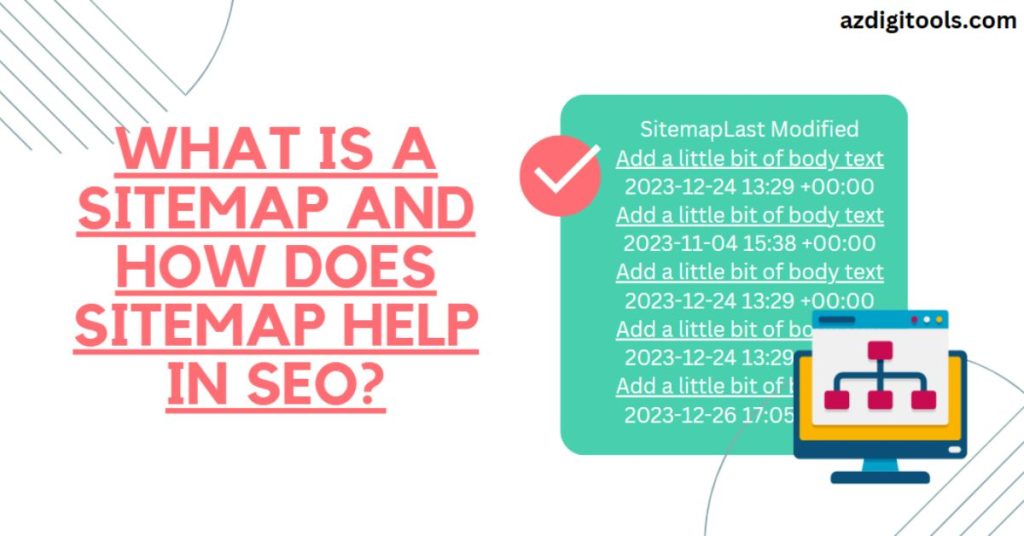
Website sitemaps are hosted files in XML format that provide search engines with a list of pages on a website for easier indexing by crawlers and indexers. They allow them to crawl and index it more efficiently.
While having a sitemap can be an important SEO technique, it should not be the sole factor to be considered when optimizing websites. There may be more urgent technical SEO concerns that should be resolved before introducing a sitemap.
What is a Sitemap?
Sitemaps are XML files that list and provide details about all of the pages within a website, providing search engines with information that helps them index its content more effectively. They’re often used to aid crawling engines in indexing web content more quickly.
Sitemaps can be submitted to Google and Bing via Webmaster Tools (formerly Webmaster Console) or online generators, making them indispensable for sites with dynamic pages that update frequently or those lacking sufficient links for regular crawling to discover.
Video Sitemaps are special types of XML Sitemaps designed to help search engines better comprehend video content. A News Sitemap exists as well, designed to aid the discovery of news articles on websites participating in Google News.
Priority> and changefreq> tags, once included in XML sitemaps, have become less important as they’ve largely been replaced by the last modified date for pages instead, but they are still helpful because priority> informs search engines how important the page is relative to others.
Also Check: What Are the Most Important SEO Ranking Factors in 2024?
How Does Sitemap Help in Website SEO?
1. Improved Crawling and Indexing
Sitemaps make it easier for search engines to index new pages by providing search engines with a comprehensive listing of URLs of pages on a website, making discovery of content faster and prioritization of indexing easier. A sitemap should be an integral component of your SEO efforts on any complex site with numerous pages or complex architecture.
Sitemaps in XML allow for additional information regarding page priorities to be provided via priority> and changefreq> tags; however, Google has made clear they do not utilize these values.
Utilizing a reliable sitemap generator and then submitting it directly to Google can be advantageous, though its use alone does not negate the need to address other technical SEO issues first. By adhering to best practices, running, ranking high on search engine results pages, and being visible to a wide range of internet users, this boosts brand image and complements SEO efforts.
2. Facilitates Page Discovery
Sitemaps enable search engine bots to intelligently crawl websites. This enables search engines to allocate their crawl budget more effectively on pages relevant to a site’s ranking over time, thus improving it over time.
Improved user experience (UX). Visitors to your website can quickly locate specific pages using an XML file, making navigation simpler and reducing frustration among those unable to find the information they were seeking before.
Last but not least, SEO tools can also be used to indicate the priority of specific pages using the lastmod> tag.
However, it should be noted that this strategy only works if its usage is consistent and verifiable – meaning no non-existent pages or redirect URLs should use the last mod to indicate their importance, or pages recently modified should use the last mod instead if indicating priority is changed often enough for accurate ranking results. These are still important tools in your arsenal for SEO!
3. Priority and Freshness Indication
When adding URLs to your sitemap file, the priority> tag allows you to indicate their relative importance by assigning them a fractional priority value that can be used to signal higher or lower ranking within search engines compared with other pages.
Furthermore, add the lastmod> tag signals when your page was last modified, though these tags don’t guarantee Google will utilize or update its index with this information.
Sitemaps serve an invaluable purpose by making it easier for search engines to discover, crawl, and index your web pages.
Without a sitemap in place, Google could take days or even weeks to discover and rank new content – not to mention double content issues that may otherwise go undetected! In addition, using a sitemap allows users to spot potential problems more quickly, like duplicate content issues that might otherwise go overlooked.
4. Error Identification
Your website could contain duplicate content, and XML sitemaps are an effective way for search engines to identify it and rank it higher in search results.
An improved user experience can be achieved with a sitemap; users will quickly and effortlessly locate the information they require quickly and effortlessly. However, it should be remembered that sitemaps do not replace internal linking strategies as such.
XML sitemaps may include additional details about pages, such as their last modification date and priority; however, Google has stated that these data values will not affect its ranking algorithms.
An XML sitemap is essential for SEO because it enables search engines to discover new pages on your site more quickly, aid in crawling processes if it contains numerous pages and links, and identify errors on the website, such as broken links or pages missing altogether.
Furthermore, an XML sitemap helps identify errors within your website – such as broken links that no longer work or missing ones – making maintenance much simpler and reducing downtime for all website visitors.
5. Optimizes Internal Linking
Sitemaps help search engines discover all pages on a website, even those not visible via normal link navigation. They’re particularly beneficial to larger sites with lots of dynamic content or orphan pages that cannot be discovered via Google.
An XML sitemap usually consists of a list of URLs, each followed by some metadata to show how often and why that page is updated on the website, as well as its priority relative to other pages on your site. Although not necessary, such information can help crawlers better traverse your website.
Most modern content management systems (like WordPress) automatically generate and submit a sitemap to Google. However, it’s best practice to check it using an SEO tool to ensure no technical obstacles are impeding its success.
Once it is error-free and you have verified it with Google via the webmaster tools account, they will revisit it periodically to index new pages or updates on existing ones.
6. Enhanced Accessibility
Sitemaps are an effective way of communicating the content of your website to search engines. While internal linking remains essential, creating a sitemap makes it easier for search engine bots to discover everything on the page, and XML sitemaps may include extra metadata on each URL, which may help Google crawlers crawl more efficiently (for instance, the last modification date, change frequency or priority over other pages).
A sitemap may not be necessary for every website, but it can certainly make life easier for search engines to index and rank pages more quickly. A sitemap is especially beneficial to sites with lots of media files (video/image files or news pages) or news pages as they help indexing take place more rapidly and rank them faster. Plus, it’s risk-free; just remember to keep it updated!
Final Words
Sitemaps are lists of pages on your website that should be crawled and indexed by search engines, such as Google. Usually stored as an XML file, they make it easier for search engines to index all the pages on your website – this can be particularly beneficial for sites with many pages or complex internal linking structures.
Sitemaps can also assist search engines with discovering pages they may otherwise overlook, as well as signaling when or how often a page has been updated or its relative priority among other pages on your website.
Search engines should be able to discover your web pages without the aid of a sitemap. However, a sitemap can provide an additional layer of SEO strategy and enhance user experience on your site.





